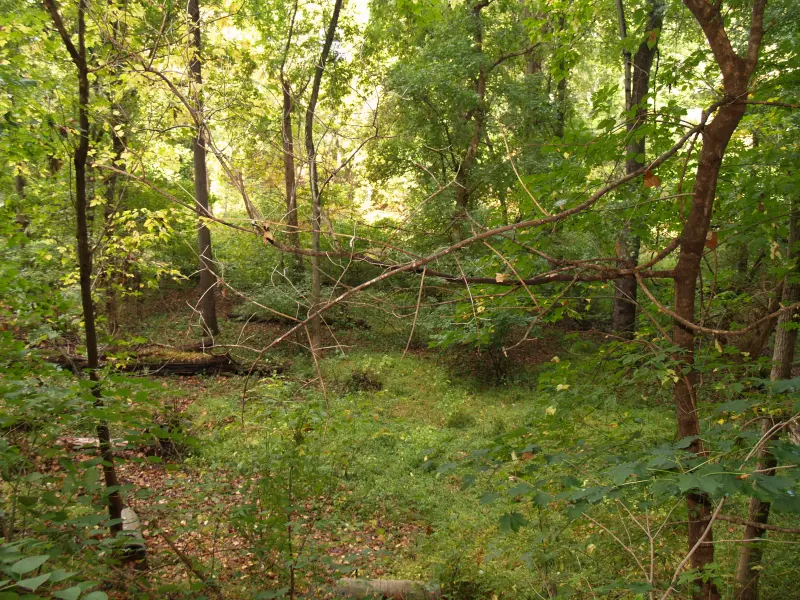Table of Contents for Downy Arrow-wood (Viburnum rafinesquianum)
Downy Arrow-wood (Viburnum rafinesquianum) is a shrub that is native to the mid-western and eastern United States and Canada. This species is a host to the holly blue (Celastrina argiolus), Spring Azure (Celastrina ladon), Henry’s elfin (Incisalia henrici) and the baltimore checkerspot (Euphydryas phaeton). Growing from 5 feet to 15 feet tall, this species grows in shrub swamps, low woods, streambanks, roadsides, fields, and swamps. The white to cream flowers bloom from May to June and the plant is hardy in zones 3-8.
Taxonomy and Naming of Downy Arrow-wood (Viburnum rafinesquianum)

by The New York Botanical Garden (licensed under CC BY 4.0)
Taxonomy
Downy Arrow-wood (Viburnum rafinesquianum) was originally named and described by Josef August Schultes, an Austrian botanist, in 1830. It has kept this same name since and is a member of the Muskroot Family (Adoxaceae).
Meaning of the Scientific and Common Names
Scientific Name
The genus name, Viburnum, derives from the Latin word for obscure or wayfaringtree. The species name, rafinesquianum, is presumably a Latinized Rafinesque, in honor of Contantine Samuel Rafinesque, a French botanist.
Common Name and Alternative Names
The common name comes from the pubescent stems. Another common name is Rafinesque’s Arrow-wood (Lariviere and Larochelle 1988) amd Missouri Viburnum (Missouri Botanical Garden).
Physical Description

- Plant Type: This plant is a shrub.
- Height: 6 ft (1.8 m) to 10 ft (3.0 m)
- Stem: The stems are erect with dark gray bark.
- Leaves: The leaves are simple, opposite, oval, and have dentate to serrate margins. They are 1.5 in (3.8 cm) to 3 in (7.6 cm) long and 1 in (2.5 cm) to 2 in (5 cm) wide. The leaves are pubescent (Reaume 2009).
- Flower color: white to cream
- Blooming period: This plant blooms from May to June.
- Fruiting type and period: This plant has drupes that are blue-black to black and mature in the fall.
Range of Downy Arrow-wood in the United States and Canada

This Viburnum is native to the mid-western and eastern United States and Canada. It is considered to be rare in the states of Alabama, Georgia, Kentucky, Massachusetts, New Hapmshire, South Dakota, Vermont, Tennessee, and Vermont.
Habitat

This species grows in open woodlands, streams, rocky hillsides (Reaume 2009), dry openings (Catling and Brownell 1999), dry brush (Bouchard, et al 1983), rocky shorelines (Rousseau 1974). limestone savanna (Alvar) (Catling and Brownell 1995), bottomland hardwoods (Krings and Franklin 2004), low woodlands (Fernald 1942), and dry thickets (Maycock and Eahselt 1997).
Hosted Insects

This viburnum is a host to the holly blue (Celastrina argiolus), spring azure (Celastrina ladon), Henry’s elfin (Incisalia henrici), the Baltimore checkerspot (Euphydryas phaeton), and the scarce fritillary (Euphydryas maturna).
Other Supported Wildlife

This species is a nectar source to other butterflies, skippers, bees, and wasps during the growing season.
Frequently Asked Questions
Does this plant have any ethnobotanical uses?
The Native American Ethobotanical Database does not list this species specifically, but Viburnums in general have been used in a lot of pharaceutical uses.
How is this plant distinguished from other Viburnums?
This viburnum is similar to the bracted arrow-wood (Viburnum bracteatum), but it has ovate to rotund leaves and stipitate glands on the cyme. This species has ovate leaves and eglandular cymes (Weakley 2022).
Is this plant invasive?
This species has not been noted as being weedy.
Gardening with Smooth Blackhaw

Hardiness
This species is hardy in zones 3-8. If your garden is within these zones and you have the right growing conditions (soil, moisture and exposure), you may well be able to grow this plant. However, if planted outside of its range, the hosted species may not recognize the plant or be harmed by ingesting a different species with an unfamiliar chemical composition.
Optimal Conditions
This species requires full sun to part-shade and dry well-drained soils.
Things of Note
This species has dull bronze-purple foliage in the fall (Koller 1981).
References
- Bouchard, Andre’, Denis Barabe’, Madeleine Dumais, and Stuart Hay. 1983. The Rare Vascular Plants of Quebec. (Ottawa, ON: National Museum of Natural Sciences).
- Catling, Paul M. and Vivian R. Brownell. 1999. Additional notes on vegetation of dry openings along the Trent River, Ontario. The Canadian Field-Naturalist 113 (3): 506-509.
- Catling, Paul M. and Vivian R. Brownell. 1995. A review of the Great Lakes Region: Distribution, floristic comparison, biogeography, and protection. The Canadian Field-Naturalist 109 (2): 143-171.
- Fernald, Merritt Lyndon. 1942. The seventh century of additions to the flora of Virginia. Rhodora 44: 457-479.
- Kolller, Gary L. 1981. Shrubs for Hillsides and Embankments. Arnoldia 41: 193.
- Krings, Alexander and Carlyle Franklin. 2004. An Annotated, Preliminary Checklist of the Vascular Flora of Camp Butner, North Carolina. Sida 21: 1131-1139.
- Lariviere, M.C. and A. Larochelle. 1988. An Annotated List of the Treehoppers (Homoptera, Membracidae) of Quebec. Entomological News 99: 111-124.
- Maycock, Paul F. and Dianne Eahselt. 1997. An inventory of ecologically significant natural vegetation in the province of Ontario: 1. Essex County. The Canadian Field-Naturalist 101: 474-486.
- Reaume, Tom. 2009. Biology of Downy Arrow-Wood (Viburnum rafinesquianum). Blue Jay 67 (2): 89-96.
- Rousseau, C. 1974. Ge’ographie floristique du Que’bec/Labrador. Distribution des principales especes vasculaires. Les Presses de of I’Universite’ Laval. Quebec 799 pp. in (Bouchard, et al 1983).
- Weakley, A.S. and Southeastern Flora Team. 2022. Flora of the southeastern United States. University of North Carolina Herbarium, North Carolina Botanical Garden.


